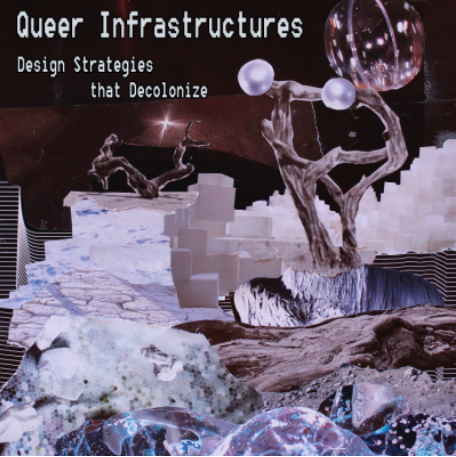QUEER THEORY
“Queer Theory has been applied to critical discourses in design, where the concept of queering can work to break down binaries found within the built environment. Queer Theory in design emerged in tandem with Queer Theory more broadly, and has shifted from population studies to broader societal reinterpretations. Queer Theory in design previously addressed a performance of identity and a specific gay male subculture within spatial environments; now we see a movement for design that shifts in alliance with a wider spectrum of gender identities which exist in public and private space.”
— Wid Bibliography 2nd Ed.
Brochu-Ingram, Gordon Brent. “Queer Infrastructures: Design Strategies That Decolonize.” Lecture, College of Environmental Design, University of California Berkeley, November 6, 2020. [lecture]
The Queer Ecological Imaginations working group examines contemporary politics of radical environmentalism from the perspective of queer epistemologies. It is a forum to think collectively about place-based strategies to resist the pernicious violence of extractive capitalism, climate catastrophe, and technocratic solutions.
“...In a time of multiple crises spanning persistent racial violence and destruction of communities from climate chaos, we can begin to explore a paradigm of queer infrastructure as part of insuring the life support resilient communities even extending to sexual health and expression of diverse cultures -- especially for the contemporary work of architects, landscape architects, and community planners on the West Coast.”
“A Queer Query.” SCI-Arc, December 5, 2020. [symposium]
A digital symposium that live-streamed from deep in the pandemic on December 5, A Queer Query is a full day of virtual conversations, presentations, and performances related to design, art, queerness, and personal, urban, rural, and digital spaces. Participants include a range of theorists, artists, and designers who are in conversations about projects, practice, and theory. As self-stated, “A Queer Query invites questions and pauses on uncertainty.
“This latest swell of interest in queerness by architects comes 30 or even 40 years after the first appearances of queer studies in the academy. But there are advantages to being late. Lateness allows us to ask more trenchant and unsettling questions. There is simply more in the rearview mirror to look at, think about, and ultimately, to doubt.”
McGregor, Erin. “The Gayborhood.” Queer Public. [podcast]
The Queer Public Podcast explores questions of contemporary queer politics and culture. This episode, sited in Philadelphia’s gay neighborhood, asks the question, “How do we create queer spaces that affirm and center black and brown people of color?” Amber Hikes, Philadelphia’s Executive Director of the Office of LGBT Affairs, discusses how she went from starting a queer nightlife production company to occupying her current role in City Hall. Hikes discusses decades-long challenges of discriminatory practices within Philadelphia’s gay community, and how racism brought to the surface of certain queer spaces sparked change.
“What’s also very cool about this space is that the first floor has the More Color More Pride flag on the wall. It’s this kind of brilliant symbolic reminder of how far we’ve come, and where we’re going really. Especially when you think about the bit of backlash we got for the flag, for a place like Taboo to say ‘we’re not only going to fly the flag outside (which they also do), but we are going to paint this wall in this color to be very clear and intentional--as soon as you get in the door--about what we stand for and who we’re in solidarity with.”
Sanders, Joel, Susan Stryker, and Terry Kogan. “Stalled!” [project]
Stalled! Was formed by a multidisciplinary research team in 2015, bringing architectural, legal, political, and cultural perspectives to bear on the development of Best Practice Guidelines for universally inclusive and safe public bathrooms. Three years of research are represented in the open-source website that includes historical context, research methodologies, and navigable prototypes of two inclusive restroom designs.
“In addition to responding to this timely architectural problem, Stalled! treats restrooms as a means to generate a larger conversation about the relationship between environmental design, the human body and social equity. The controversies surrounding transgender bathrooms is just one example of the way civil liberties of people including women, African-Americans, Muslims, immigrants, the disabled and the LBGTQ community to name a few, are imperiled both in this country and around the world by denying people safe access to public space.”
“Queering The Map.” [platform]
Queering the Map is a crowd-sourced counter-mapping platform that seeks to collectively record the ‘cartography of queer life’ and the connections between LGBTQ2IA+ community members across political borders. Initially conceived of and designed by grassroots volunteers, the project includes pins from all over the world.
“A queer approach to space points out the limitations of the ways in which the world around us is produced and normalized by and for certain bodies and not others. It is pertinent that we continuously reflect and act on the ways in which LGBTQIA+ life is complicit in ongoing processes of settler-colonialism. How does race, gender, sexuality, citizenship, ability, and class affect the ways in which we relate to, move through, and create space?”







